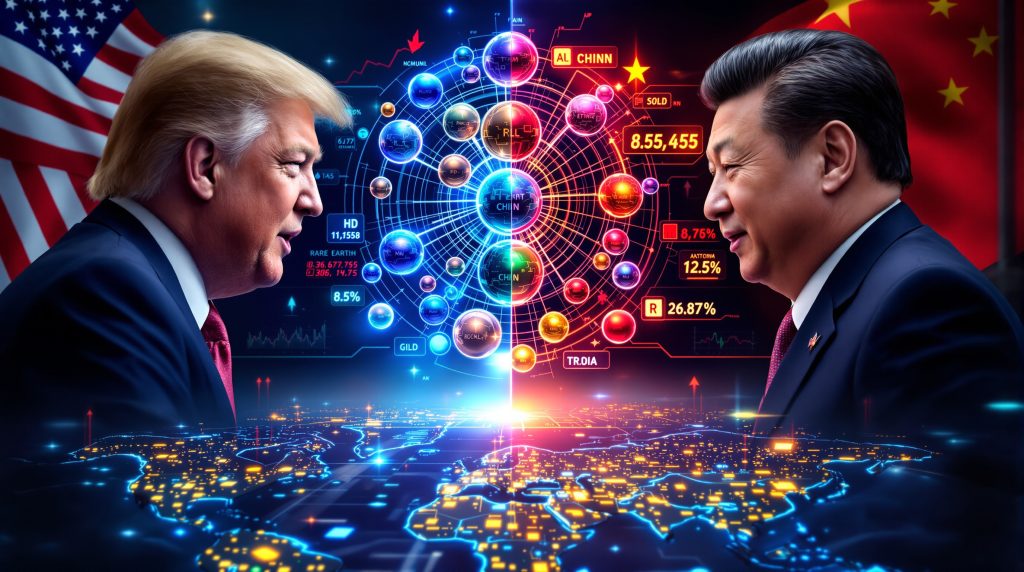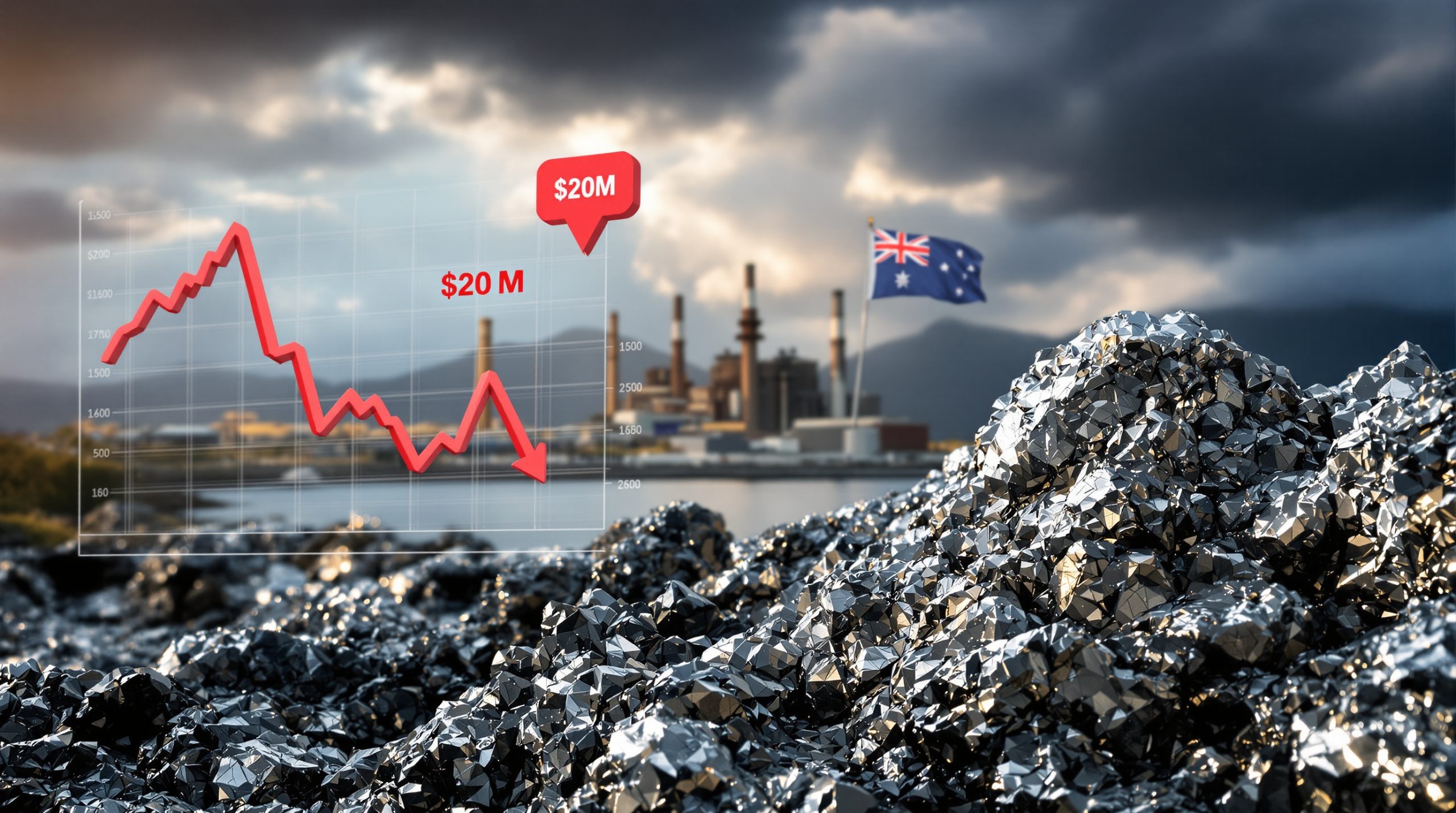Trump's Rare Earth Tariff Threat: Global Economic Implications
In a dramatic escalation of US-China trade tensions, President Donald Trump threatened to impose "massive" tariff increases on Chinese imports after Beijing expanded export controls on rare earth elements. This development signals a potential return to heightened trade hostilities between the world's two largest economies following a period of relative diplomatic stability.
Timeline of Recent Trade Tensions
The latest flare-up began on October 10, 2025, when China announced expanded rare earth export controls, adding five new elements to its restricted list. Trump responded swiftly with Trump tariff impact through his Truth Social platform on the same day, declaring he would be "forced, as President of the United States of America, to financially counter their move."
This confrontational exchange has put a planned meeting between Trump and Chinese President Xi Jinping in jeopardy. The leaders were scheduled to meet at the APEC summit in South Korea approximately three weeks after the announcement, but Trump stated he now saw "no reason to do so."
Previous US-China trade negotiations had temporarily stabilized relations following painstaking diplomacy earlier in the year. However, this recent development threatens to unravel that progress.
What Are Rare Earth Elements and Why Do They Matter?
Strategic Importance of Rare Earth Minerals
Rare earth elements comprise 17 metallic elements essential for high-tech manufacturing. Despite their name, most are relatively abundant in Earth's crust but rarely concentrated in economically viable deposits.
These minerals serve as critical components in electric vehicles, wind turbines, and sophisticated military equipment. They're indispensable in semiconductor production, smartphones, and precision-guided weapons systems. Their importance has grown significantly with the expansion of green technology and advanced defence minerals supply chain applications.
China's Dominant Market Position
China maintains an extraordinary grip on the global rare earth supply chain, controlling over 90% of the world's processed rare earths and rare earth magnets. This dominance gives Beijing significant leverage in international trade and technology development.
The recent restrictions added five elements to China's export control list, implemented extra scrutiny for semiconductor industry users, and added dozens of refining technologies to the control list. Perhaps most significantly, China extended compliance requirements to foreign producers using Chinese materials—effectively extending Chinese regulatory authority beyond its borders.
What Exactly Did Trump Threaten in Response?
Trump's Specific Tariff Threats
In his Truth Social announcement, Trump's critical minerals order promised "massive" increases on Chinese imports if China proceeded with its rare earth restrictions. While previous US tariff levels on Chinese goods had varied widely during earlier trade disputes, Trump's language suggested potential for even higher tariffs than seen in previous trade tensions.
Trump also made a bold claim about American resource capabilities, stating: "For every Element that they have been able to monopolize, we have two." This assertion suggests confidence in America's ability to develop alternative supply chains, though experts note significant challenges in rapidly scaling up processing capacity.
Diplomatic Consequences
The immediate diplomatic fallout was substantial. Trump canceled his planned meeting with President Xi at the upcoming APEC summit, stating there seemed "no reason" to proceed with the diplomatic engagement. This marks a sharp reversal from earlier progress in US-China relations.
Trump accused China of attempting to hold the "global economy hostage" with its rare earth controls and characterized China's decision as "hostile." He claimed that China was "sending letters to countries worldwide saying it planned to impose export controls on every element of production related to rare earths," though independent verification of this claim is pending.
How Did Markets React to the Escalating Tensions?
Immediate Financial Impact
Financial markets responded quickly and negatively to the escalating tensions. The S&P 500 index dropped approximately 2% following Trump's announcement, demonstrating investors' concerns about renewed trade hostilities.
Investors fled to safe-haven assets including US Treasury securities, sending yields on those assets lower. Gold prices strengthened as market uncertainty increased, and the US dollar weakened against a basket of foreign currencies, reflecting international concerns about the potential tariffs impact investment markets.
Supply Chain Implications
The market reaction highlighted renewed concerns about technology supply chain disruptions. Companies dependent on rare earth components for manufacturing face potential sourcing challenges and price volatility.
The situation creates particular uncertainty for consumer electronics manufacturers, green technology producers, and defense contractors. Some analysts suggest this may accelerate investment in non-Chinese rare earth development projects as companies seek to diversify their supply chains.
What Is China's Rare Earth Strategy?
Recent Export Control Expansion
China's October 10 announcement significantly expanded its rare earth export controls. While the specific five elements added were not identified in initial reports, the measures included additional scrutiny for semiconductor industry users—a sector already facing significant trade restrictions.
The controls added dozens of refining technologies to China's export restriction list, potentially limiting the development of competing processing facilities in other countries. By extending compliance requirements to foreign producers using Chinese materials, China effectively expanded its regulatory reach throughout the global supply chain.
Strategic Objectives
China's moves appear aimed at leveraging its dominant market position in these critical minerals. By controlling access to rare earths and processing technologies, China maintains a significant technological advantage in numerous high-tech industries.
The timing of the announcement suggests these restrictions may serve as a counter to US semiconductor export controls that have hampered China's technological development in recent years. The measures also help China secure greater control over strategic supply chains as global competition for technological leadership intensifies.
How Might This Affect Global Supply Chains?
Potential Industry Disruptions
The electronics manufacturing sector faces potential component shortages if the dispute escalates further. Manufacturers of smartphones, computers, and other consumer electronics rely heavily on rare earth components for functionality and performance.
Green technology deployment could experience delays and cost increases, particularly for wind turbines and electric vehicles that require significant quantities of rare earth elements for motors and generators. Defense contractors might encounter procurement challenges for advanced weapons systems and communications equipment.
Across multiple technology sectors, price increases seem likely as supply uncertainties push manufacturers to secure inventory and develop alternatives.
Alternative Supply Development
The dispute will likely accelerate investment in non-Chinese rare earth mining and processing. Countries with significant rare earth deposits—including Australia, the United States, Canada, and Brazil—may see increased development interest as companies seek to diversify supply chains.
Industry experts anticipate renewed focus on recycling and material recovery technologies to extract rare earths from electronic waste. Research into substitute materials could gain funding priority as companies seek to reduce dependency on restricted elements.
Some nations may consider strategic stockpiling of critical minerals to buffer against future supply disruptions, similar to petroleum reserves maintained for energy security.
What Are the Economic Stakes in This Dispute?
Trade Volume Implications
Bilateral trade between the US and China represents one of the world's largest economic relationships, with hundreds of billions of dollars in goods exchanged annually. Previous trade disputes significantly reduced trade volumes and disrupted established supply chains.
If implemented, substantial tariff increases would affect a wide range of consumer goods imported from China, potentially raising prices for American consumers and businesses. Manufacturing sectors in both countries remain vulnerable to disruption from extended trade hostilities, according to recent reports from The Guardian.
Strategic Economic Competition
The rare earth dispute represents just one aspect of broader strategic competition between the US and China for technological and economic leadership. Control of critical minerals provides leverage in this competition, particularly as advanced industries like artificial intelligence, quantum computing, and renewable energy grow in importance.
Both nations are seeking advantage in emerging industries that will shape the future economy. This competition extends beyond trade to technological standards, research capabilities, and global influence.
Critical minerals are increasingly viewed as national security assets by major economies, similar to energy resources in previous decades. This security dimension complicates purely economic calculations in trade negotiations.
How Might Other Countries Respond?
Global Economic Ripple Effects
Supply chain disruptions likely to affect third-party nations that manufacture products using Chinese rare earth materials or American technology. Many Asian manufacturing hubs particularly vulnerable to disruptions in either market.
Global consumers could face price increases for technology products if manufacturing costs rise due to material shortages or tariffs. Companies may pass these costs to consumers, potentially slowing adoption of new technologies.
The situation creates opportunities for alternative suppliers in countries with rare earth deposits. Australia, which has significant rare earth mining operations, Brazil, with substantial untapped reserves, and Canada, with growing rare earth development projects, could see increased investment.
Some manufacturing companies may accelerate "friend-shoring" strategies—relocating production to politically aligned countries to reduce supply chain vulnerabilities.
Diplomatic Positioning
Major economies may face difficult choices if the US-China dispute intensifies. Countries with strong economic ties to both superpowers could find themselves pressured to align with one side or the other on technology standards and supply chain integration.
Regional trading partners in Asia and Europe face particular challenges navigating between competing American and Chinese interests while maintaining economic growth. Several have already begun developing strategies to reduce dependency on either power.
Multilateral approaches to critical mineral access could gain traction, with groups of countries potentially forming consortiums to develop resources and processing capabilities outside Chinese control. International organizations may attempt to mediate, though past efforts have met with limited success in US-China disputes.
What Are the Long-Term Implications for Rare Earth Markets?
Market Diversification Efforts
The dispute will likely trigger increased investment in rare earth mining outside China. While developing new mines takes years, existing projects may receive accelerated funding and permitting priority as supply security concerns grow.
Development of alternative processing capabilities represents a particular challenge, as China's technical expertise in rare earth separation and refinement is substantial. However, several countries are working to establish competing facilities, though most remain years from full-scale operation.
Research into substitutes for critical minerals will likely receive increased funding from both governments and industry. Some applications may achieve breakthroughs that reduce dependency on specific rare earth elements.
Recycling and urban mining initiatives—extracting rare earths from electronic waste—will probably accelerate as companies seek to secure materials from sources not subject to export controls.
Strategic Industry Responses
Technology companies may redesign products to reduce dependency on restricted materials. This could include both material substitution and architectural changes to minimize use of vulnerable components.
Defense contractors will likely secure alternative supply chains for critical materials, potentially developing dedicated facilities or long-term supply agreements with non-Chinese producers. National security concerns will drive government support for these efforts, as detailed in recent critical minerals strategy documents.
Green technology manufacturers may explore material alternatives and redesign key components to reduce rare earth requirements. Some are already developing motors and generators that use fewer or different rare earth elements.
International consortiums combining government support and private investment could emerge to develop new sources of rare earth materials outside China's control. These joint efforts could pool technical expertise and financial resources to overcome the high barriers to market entry.
FAQs About the US-China Rare Earth Dispute
What are rare earth elements and why are they important?
Rare earth elements comprise 17 metallic elements essential for manufacturing high-tech products. They enable miniaturization of electronics, powerful permanent magnets for motors, and specialized optical properties for displays and lasers.
These elements are crucial components in smartphones, electric vehicles, wind turbines, and military equipment. Despite their name, most are relatively abundant in Earth's crust but rarely found in concentrated, economically viable deposits.
Why does China dominate the rare earth market?
China's dominance stems from decades of strategic investment in mining and processing capabilities. Beginning in the 1980s, China identified rare earths as a strategic sector and provided government support for industry development.
Historically less stringent environmental regulations allowed Chinese producers to operate at lower costs than competitors in other countries. This cost advantage, combined with strategic government support, allowed China to develop unmatched expertise and infrastructure for rare earth extraction and processing.
Over time, this dominance became self-reinforcing, as manufacturers located production facilities near reliable material sources and processing know-how concentrated in Chinese industrial centers.
How might tariffs affect consumer prices?
Increased tariffs could raise prices on a wide range of consumer goods imported from China. Products with electronic components would be particularly vulnerable to price increases, as Reuters reported.
Additionally, restricted access to rare earth elements could increase manufacturing costs for electronics, appliances, and vehicles as companies pay premiums for limited materials or invest in redesigning products to use alternatives.
These manufacturing cost increases would likely be passed to consumers in the form of higher retail prices globally. The extent of price increases would depend on the severity and duration of trade restrictions.
What alternatives exist to Chinese rare earth supplies?
Several countries possess rare earth deposits, including Australia, the United States, Canada, and Brazil. However, developing mining operations and especially processing capabilities requires significant time and investment.
The Mountain Pass mine in California represents America's primary rare earth production facility, though it currently sends materials to China for processing. Australian operations have expanded significantly in recent years, becoming the second-largest producer of rare earth concentrates.
Recycling technologies and material substitution research represent additional alternatives, though neither can fully replace primary production in the near term. Advanced recycling facilities can recover rare earths from electronic waste, but collection and processing remain challenging.
How might this dispute affect green technology deployment?
Green technologies like wind turbines and electric vehicles rely heavily on rare earth elements, particularly neodymium, praseodymium, and dysprosium for high-performance permanent magnets.
Supply restrictions or price increases could slow deployment rates and increase costs for renewable energy projects and electric transportation initiatives worldwide. Manufacturers might face difficult choices between absorbing higher costs, raising prices, or redesigning products.
The dispute could accelerate research into alternative motor designs that use fewer rare earth materials, though such redesigns typically involve performance trade-offs. Companies with established non-Chinese supply chains would gain competitive advantage in maintaining production volumes.
Ready to Track the Next Major Mineral Discovery?
Discover how significant mineral discoveries can lead to substantial market returns by exploring Discovery Alert's dedicated discoveries page, where our proprietary Discovery IQ model transforms complex mineral data into actionable investment insights for ASX investors seeking a market-leading advantage.




